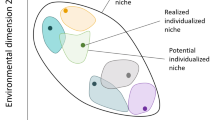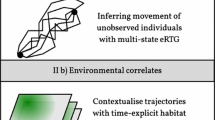Abstract
Short-term and long-term population growth rates can differ considerably. While changes in growth rates can be driven by external factors, we consider another source for changes in growth rate. That is, changes are generated internally by gradual modification of population structure. Such a modification of population structure may take many generations, particularly when the populations are distributed spatially in heterogeneous environments. Here, the net reproductive rate R 0 is not sufficient to characterize short-term growth. Indeed, a population with net reproductive rate greater than one could initially decline precipitously, or a population with net reproductive rate less than one could initially grow substantially. Thus, we augment the net reproductive rate with lower and upper bounds for the transient reproductive rate, R l and R u . We apply these measures to the study of spatially structured salmon populations and show the effect of variable homing fidelity on short-term and long-term generational growth rates.









Similar content being viewed by others
References
Al-Chokhachy R, Budy P (2008) Demographic characteristics, population structure, and vital rates of a fluvial population of bull trout in Oregon. Trans Am Fish Soc 137:262–277
Allen L (1987) Extinction and critical patch number for islands populations. J Math Biol 24:617–625
Berman A, Plemmons RJ (1994) Nonnegative matrices in the mathematical sciences, Society for Industrial and applied Mathematics, Philadelphia, Pennsylvania. U.S.A
Bowerman T, Budy P (2012) Incorporating movement patterns to improve survival estimates for juvenile bull trout. North Am J Fish Manag 32:1123–1136
De-Camino-Beck T, Lewis MA (2007) A new method for calculating net reproductive rate from graph reduction with application to the control of invasive species. Bull Math Biol 69:1341–1354
Caswell H (2001) Matrix Population Models. Sinauer Assosiate, Sunderland
Caswell H, Neubert MG (2005) Reactivity and transient dyanmics of discrete-time ecological systems. J Differ Equ Appl II 4-5:295–310
Cushing J, Zhou Y (1994) The net reproductive value and stability in matrix population models. Nat Resour Model 8:297–333
Deangelis DL, Post WM, Travis CC (1986) Positive Feedback In Natural Systems, vol 15. Springer-Verlag, New York
Ellner S (1984) Asymptotic behavior of some stochastic difference equation population models. J Math Biol 19:169–200
Ezard THG, Bullock JM, Dalgleish HJ, Million A, Pelletier F, Ozgul A, Koons DN (2010) Matrix models for a changeable world: the importance of transient dynamics in population management. J Appl Ecol 47:515–523
Fahrig L, Merriam G (1985) Habitat patch connectivity and population survival. Ecology 66:1762–1768
Fraley JJ, Shepard BB (1989) Life history, ecology and population status of migratory bull trout (Salvelinus confluentus) in the Flathead lake and river system, Montana. Northwest Sci 63:133–143
Gadgil M (1971) Dispersal: Population consequences and evolution. Ecology 52:253–261
Hamilton WD, May RM (1977) Dispersal in stable habitats. Nature 269:578–581
Hanski IA, Gilpin ME (1997) Metapopulation biology: Ecology, genetics, and evolution. Academic Press, San Diego, California
Hastings A (2001) Transient dynamics and persistence of ecological systems. Ecol Lett 4:215–220
Hastings A (2004) Transients: the key to long-term ecological understanding Trends Ecol Evol 19:39–45
Hastings A, Botsford L (2006) Persistence of spatial populations depends on returning home. Proc Nat Acad Sci USA 103:6067–6072
Horn HL, Macarthur RH (1972) Competition among fugitive species in harlequin environment. Ecology 53:749–752
Horn RA, Johnson CR (2013) Matrix Analysis. 2nd edition
Kareiva P (1990) Population dynamics in spatially comples environments: Theory and data. Phil Trans R Soc Lond B 330:175–190
Koons DN, Holmes RR, Grand JB (2007) Population inertia and its sensitivity to changes in vital rates and population structure. Ecology 88:2857–2867
Levin SA, Cohen D, Hastings A (1984) Dispersal stratgies in patch environment. Theor Popul Biol 26:165–191
Pulliam HR (1988) Source, sinks, and population regulation. Am Nat 132:652–661
Li C, Schneider H (2002) Applications of Perron-Frobenius theory to population dynamics. J Math Biol 44:450–462
Macarthur RH, Wilson EO (1967) The theory of island biogeography. Princeton University Press, Princeton, NJ
McPhail JD, Baxter JS (1996) A review of bull trout life-history and habitat use in relation to compensation and improvement opportunities, Fisheries Management Report No. 104
Neubert MG, Caswell H (1997) Alternatives to resilience for measuring the responses of eoclogical systems to perturbations. Ecology 78:653–665
Ortega JD (1987) Matrix Thory: A Second Course. Plenum Press, New York
Pacific Salmonids (2014) Major Threats and Impacts, NOAA fisheries office of protected resource, http://www.nmfs.noaa.gov/pr/species/fish/salmon.htm
Rieman BE, Dunham JB (2009) Metapopulations and salmonids: a synthesis of life history patterns and empirical observations. Ecol Freshwat Fish 9:51–64
Rogers A (1968) Matrix analysis of international population growth and distribution. University of California Press, Berkeley, California
Rogers A (1995) Multiregional demography: Principles, methods and extensions. Wiely, New York
Rueffler C, Metz JAJ (2013) Necessary and sufficient conditions for R 0 to be a sum of contributions of fertility loops. J Math Biol 66:1099–1122
Schreiber SJ (2010) Interactive effects of temporal correlations, spatial heterogeneity and dispersal on population persistence. Proc Royal Soc B 277:1907–1914
Stewart IJ, Carlson SM, Boatright CP, Buck GB, Quinn TP (2004) Site fidelity of spawning sockeye salmon (Oncorhynchus nerka W.) in the presence and absence of olfactory cues. Ecol Freshwat Fish 13:104–110
Stott I, Townley S, Hodgson DJ (2011) A framework for studying transient dynamics of population projection matrix models. Ecol Lett 14:959–970
Townley S, Carsilake D, Smith OK, Mccarthy D, Hodgson D (2007) Predicting transient amplification in perturbed ecological systems. J Appl Ecol 44:1243–1251
Thomas CD, Kunin WE (1999) The spatial structure of populations. J Anim Ecol 68:647–657
Underwood K, Cramer SP (2007) simulation of human effects on bull trout population dynamics in Rimrock Reservoir, Washington. Ametican Fish Soc 53:191–207
Vance RR (1984) The effect of dispersal on population stability in one-species, discrete-space population growth models. Am Nat 123:230–254
Salmonidae (2014) Animal diversity web, http://animaldiversity.ummz.umich.edu/accounts/Salmonidae/
Acknowledgments
The authors wish to thank Alex Potapov, Andrew Paul, P. van den Driessche, and Lewis Lab for fruitful discussions. Q.H. gratefully acknowledges support from the Alberta Environment and Sustainable Resource Development and the Alberta Water Research Institute. M.A.L. also gratefully acknowledges a Canada Research Chair, NSERC Discovery and Accelerator grants, and a Killam Research Fellowship.
Author information
Authors and Affiliations
Corresponding author
Appendices
Appendix A: Graph reduction method
This method starts with the description of the projection matrix as a life cycle graph. Once the life cycle graph has been specified, the calculation procedure is as follows. (1) Identify survivorship and fecundity transitions. (2) Multiply all fecundity transitions in the graph by \(R^{-1}_{0}\).(3) Eliminate survivorship self-loops, using rule a in Fig. 10. (4) Reduce the graph using the graph reduction rules defined in Figure I until only nodes with fecundity self-loops are left. When a node is eliminated, all pathways that go through that node have to be recalculated. (5) If only one node with a single self-loop is left, eliminate the final node by setting the self-loop equal to 1 and solve this equation for R 0.
Appendix B: Proof of (1.6)
To investigate the function P x, we let P = (p i j ) n×n and x = [x 1, x 2, ⋯ , x n ]T. A simple calculation gives
Noticing that \(\sum \limits _{i=1}^{n}p_{ij} (j=1, \cdots , n)\) is the j th column sum of the matrix P, we consider the smallest such column sum of P. Suppose that for some 1 ≤ k ≤ n, \(\sum \limits _{i=1}^{n}p_{ik}=\min _{1\leq j\leq n}\sum \limits _{i=1}^{n}p_{ij}\), then the function ||P x||1 has minimum value \(\sum \limits _{i=1}^{n}p_{ik}\) when x is a unit vector with x k = 1 and x j = 0 (j ≠ k). That is to say,
the minimum sum of column vectors of projection matrix P.
Appendix C: R 0 for resident salmonids
In terms of the life cycle of resident species, we divide the population into four groups: fertilized egg (E), fry (F), juvenile (J), and adult (A). We take time unit to be 1 year. The population vector is x(t) = [E(t), F(t), J(t), A(t)]T, which represents the population density of each stage at the end of the breeding season in year t. We relate the population density of each stage at time t + 1 to time t by the matrix equation
where the projection matrix P is
Here, b is the average number of fertilized eggs produced per adult per year, p f e is the proportion of eggs that hatch to fry stage each year, p j f is the proportion of fry that survive to the juvenile stage each year, p j j is the proportion of juveniles that survive to remain as a juvenile per year, p a j is the proportion of juveniles that survive to become adults each year, p a a is the proportion of adults that survive each year. The vital rates of salmonids living a variety of environment have been estimated by many researchers (e.g., (Al-Chokhachy and Budy 2008; Bowerman and Budy 2012; McPhail and Baxter 1996)).
The matrix Eq. 26 models the dynamics of resident salmonids population. The net reproductive rate, R 0, for this population can be calculated using the graph reduction method, as mentioned in Appendix A. The graph reduction method is shown in Fig. 11.
From the equation of R 0 (Fig. 11d), we see that the proportion of individuals that start as eggs and eventually mature and survive to become breeding adults is p f e p j f p a j /[(1−p j j )(1−p a a )], and the expected number of eggs produced per breeding adult is b. Multiplying these quantities yields R 0.
Appendix D
Appendix E
Appendix F: An analytical calculation of ∂ R/∂ 𝜖 when 𝜖 is close to 0 and 1
We differentiate the Eq. 15 with respect to 𝜖 to get
Thus,
Hence,
Noticing that R 0(0+) = max{G 21 G 12, G 43 G 34}, we find
Since R 0(1−) = max{G 23 G 32, G 41 G 14}, similar computation yields
If 0 < 𝜖 ≪ 1, the function R 0(𝜖) can be approximated by a straight line
with negative slope.
Similarly, if 𝜖 is less than and sufficiently close to 1, then we have
with positive slope.
Appendix G: Further discussion about R l and R u
For the matrix Q, we define the range of Q as Ran\((\mathbf {Q}) = \{\mathbf {Q}x|x\in \mathbb {R}^{n}\}\), and the null space of Q as \(\mathcal {N}(\mathbf {Q}) = \{x\in \mathbb {R}^{n}|\mathbf {Q}x=0\}\).
Then both Ran (Q) and \(\mathcal {N}(\mathbf {Q})\) are subspaces of \(\mathbb {R}^{n}\), and \(\mathbb {R}^{n}=\text {Ran}(\mathbf {Q})\bigoplus \mathcal {N}(\mathbf {Q})\). Therefore, for any \(x\in \mathbb {R}^{n},\) there exists unique x Ran ∈ Ran(Q) and unique \(x_{\mathcal {N}}\) such that \(x=x_{\text {Ran}}+x_{\mathcal {N}}\). Thus, for any \(x\in \mathbb {R}^{n},\) \(\mathbf {Q}x=\mathbf {Q}x_{\text {Ran}}+\mathbf {Q}x_{\mathcal {N}}=\mathbf {Q}x_{\text {Ran}}+0\). The projection of any \(x\in x_{\mathcal {N}}\) will give zero individual in the next generation, which is not of biological interest. For this reason, we restrict x ∈ Ran(Q) when defining R l and R u .
Appendix H: A multiple-patch model
If we assume that there are I small rivers in upstream and K big rivers in downstream, it is not difficult to extend the four-patch model (12) to a multiple-patch model:
for i = 1, 2, ⋯ , I and k = 1, 2, ⋯ , K.
Rights and permissions
About this article
Cite this article
Huang, Q., Lewis, M.A. Homing fidelity and reproductive rate for migratory populations. Theor Ecol 8, 187–205 (2015). https://doi.org/10.1007/s12080-014-0243-7
Received:
Accepted:
Published:
Issue Date:
DOI: https://doi.org/10.1007/s12080-014-0243-7










